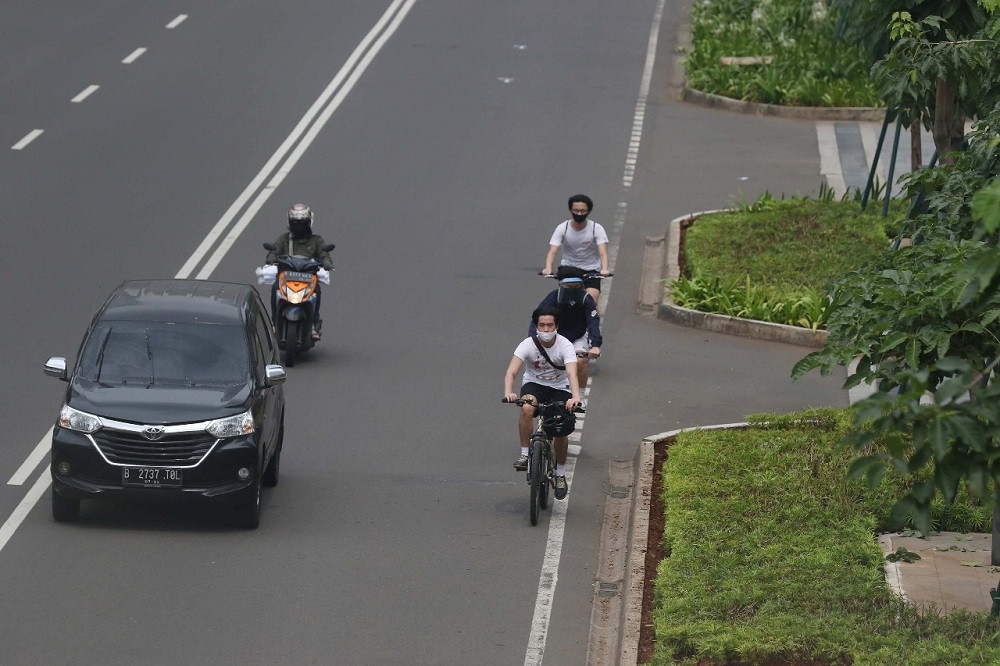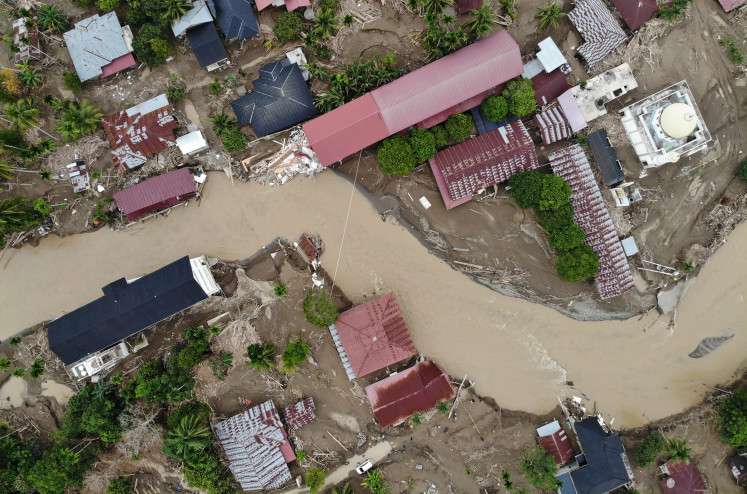Popular Reads
Top Results
Can't find what you're looking for?
View all search resultsPopular Reads
Top Results
Can't find what you're looking for?
View all search resultsAmid pandemic bike boom, invest in wheels of change
The Jakarta government should seize the bicycle madness as an opportunity to invest in the permanence of a hospitable biking environment, to turn the bicycle into the preferred mode of transportation in the new normal era. Subsequently, many other large Indonesian cities could imitate the bicycle revolution.
Change text size
Gift Premium Articles
to Anyone
H
ow to maintain your health when gyms and swimming pools are closed? How to reach your destination when you fear crowded public transport? What can benefit economic recovery from this pandemic? The answer is simple: ride a bicycle.
Jakarta has entered the “new normal”, so has the bicycle. The pandemic has created a massive bike craze. June saw a 500 percent increase of cycling activity in Jakarta, compared to October 2019. While COVID-19 has battered most of the economy, the bicycle industry has seen a huge boom. The Jakarta government should seize the bicycle madness as an opportunity to invest in the permanence of a hospitable biking environment, to turn the bicycle into the preferred mode of transportation in the new normal era. Subsequently, many other large Indonesian cities could imitate the bicycle revolution.
Read also: Jakartans turn to bicycles to commute in ‘new normal
For residents of a city hard hit by COVID-19 such as Jakarta, maintaining physical and mental health has become crucial. As an alternative to canceled sport events and reduced opening hours of public sport areas, cycling proves effective to maintain health while keeping social distance. People who hop in the saddle on a regular basis reduce stress and anxiety and are less likely to have chronic diseases, which would otherwise put extra burden on already overwhelmed health workers.
Recent research by Harvard University has revealed the relation between air pollution and increased vulnerability to the most severe COVID-19 outcomes, including more hospitalization and higher death rates. Considering Jakarta’s bad air quality, it is thus more crucial then ever to invest in alternatives to air polluting motor-based mobility. Cycling as a mode of transportation will increase the city’s accessibility, which is essential for economic growth. Contrariwise, congestion costs Jakarta some Rp 65 trillion (US$4.5 billion) per year.
Many other cities around the world have long embraced cycling as one of the main modes of transport to accommodate challenges coinciding with urbanization. An example is Amsterdam. The Dutch capital has around 2 million bicycles, and all of Amsterdam’s cyclists together cycle around 2 million kilometers per day. To improve and maintain the city’s accessibility and livability, the Amsterdam authority has invested in, among other things, multilevel bike parks next to the central station, development of bike lanes and bicycle safety campaigns.
The bike boom could have a lasting, positive impact on Jakarta as well – even well beyond the pandemic – but only with ample political will to invest in a durable biking infrastructure. A lack of safety among cyclists is a huge challenge to keep the popularity of cycling alive. As long as bike lanes are only separated by stripes or traffic cones instead of permanent and physical separators, it will be no surprise that the bike craze coincides with a rising number of traffic accidents that will be a blow to cycling popularity. Motorized vehicles often drive or even park on bicycle lanes. From January 2020 to June 2020, 29 bicycle accidents were registered on Jakarta’s highways, of which 58 percent were fatal to cyclists.
Read also: On yer bike: cycling industry out-pedaled by demand
It would be an illusion to think that reallocating road space from cars to bicycles will come without resistance, considering Indonesia’s powerful and active car lobby. Motor-based mobility has dominated Jakarta’s street view for many years, and this will not suddenly change with the bike craze and the reopening of offices, malls and other public places.
Jakarta can learn from the situation in London what to expect when cycling plans and closure of roads lack sufficient government guidance and are pushed through without considering the consequences for people who have no other option than driving a car, such as elderly and disabled people. Soon after the London government unveiled one of the most ambitious cycling schemes worldwide, local conservative politicians objected to plans for new cycle routes and many cycling route signs have been defaced.
Resistance from drivers who must sacrifice their lane might eventually fade, as evidenced 15 years ago with the introduction of the Transjakarta bus service. Whereas many drivers initially resisted the idea of relenting a lane exclusively for the bus, the Transjakarta has enjoyed increasing popularity and has changed the way Jakartans view buses.
With sufficient government effort to balance the different needs of road users, the same could happen with the bicycle. Motorized vehicles can still use their lanes if the Jakarta government invests in a visible signposted cycle network that facilitates cyclists to take shortcuts or alternative routes that reach far beyond the city center. Incentives such as tax deductions for bike purchases, reducing cyclists’ health insurance premium, and employee benefits when commuting to work by bike are needed to normalize the bicycle for urban mobility.
Whereas normalizing the bike as the preferred mode of transportation is very much dependent on a hospitable biking infrastructure, cyclists also bear responsibility themselves. Riding without a light, against traffic and ignoring traffic signs will make it difficult for cyclists to get their voices heard. Alongside infrastructure investments, education about proper road usage and subjecting cyclists to safety obligations should be prioritized as well.
Read also: Cycle of crime? Brompton bikes seized over regulatory discrepancy in Indonesia
One could wonder whether it is the right time to spend the municipal budget on urban space reconfiguration, considering that Indonesia’s economic recovery and an overwhelmed health sector need every rupiah. But with the pandemic far from over and with the absence of a reliable vaccine, many people will remain reluctant to jump into a pool for their regular exercise or to use crowded public transportation and ridesharing whereby social distancing is impossible. The benefits of investing now in a cycle infrastructure will eventually outweigh its costs and extra expenditure on congestion, air pollution and health.
Everything will be reopened in a different way in this ”new normal” era, so should the position of the bicycle in Jakarta’s attempt to move again. Only then will the bicycle become a vehicle with wheels of change.
***
The writer is an avid cyclist, who has cycled in many urban places including in Indonesia, France, Vietnam and the Netherlands.










